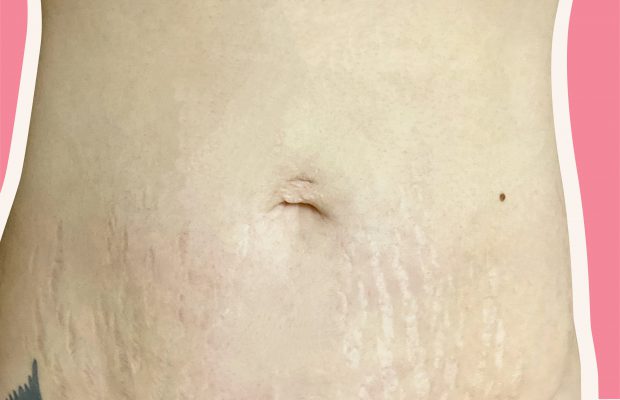Updated 12/2/20 Stretch marks are a normal part of growth, a normal part of skin, and something many of us can develop during our teenage years — especially during rapid weight gain. Puberty typically entails a lot of growth, and on top of that, your collagen is much stronger and tighter when you’re younger. Because of this, there is more trauma and inflammation when the skin is stretched during your teenage years.
While developing some amount of stretch marks during puberty is common, they can also develop later in life if our bodies experience extreme fluctuations. This includes pregnancy as well as rapid weight gain unrelated to pregnancy. When it comes to these changes, prevention is key. Keep reading to learn more about what causes stretch marks and how to prevent or minimize them.
What Causes Stretch Marks?
Stretch marks occur when the body grows faster than the skin can keep up with, like during rapid weight gain or pregnancy. When this happens, collagen and elastin fibers in the dermis layer of the skin can’t hold together. This results in tears and injury to the skin. Stretch marks are essentially scars that have formed from the inside out, and despite what some beauty companies try to sell you on, they are virtually impossible to get rid of once they have formed. (I wish had better news for you!) Stretch marks appear reddish, purple, or dark brown in color, depending on your skin tone, but after pregnancy or weight gain, once the skin is no longer expanding, they will gradually fade.
In pregnant women, stretch marks most often start to appear after month six or seven on the belly, breasts, and buttocks.
With rapid weight gain not related to pregnancy, they can occur at any time.
How Can I Prevent Stretch Marks?
Despite what some salespeople or other skin professionals may try to sell you, I have not seen or heard of anything truly effective for getting rid of stretch marks. Trust me, if there was, we would all know about it. The only real control you have is in preventing them from appearing or, at the very least, minimizing them right after they start to appear.
As for prevention, there is some data that shows that when women who applied body moisturizer on a regular basis during their pregnancy got far fewer stretch marks compared to a control group that didn’t apply moisturizer. The idea is that when the skin is consistently moist and the lipid barrier is intact, it can better protect itself from injury and is more able to deal with trauma, such as expanding skin.
But as an esthetician who has been working with skin for over thirty years now, I know that not all creams will do the trick. Some are poorly formulated and don’t use the right ingredients to repair the lipid moisture barrier and prevent transepidermal water loss. Luckily, there have been many breakthroughs in the science of moisture retention, and it all comes down to choosing the right ingredients.
To truly strengthen the skin and deeply moisturize, look for the following emollient, barrier-repairing ingredients when choosing a body moisturizer or oil to use on the expanding areas:
Borage Oil
Bois De Rose Oil
Carrot Oil
Evening Primrose Oil
Cranberry Oil
Ceramides
Linoleic/Linolenic Acids
Squalane
Linoleic Acid
Tocopheryl Linoleate
Phytosterols
Shea Butter
Sunflower Oil
Soybean Oil
Safflower Oil
Jojoba Oil
Sweet Almond Oil
Canola Oil
Sesame Seed Oil
These ingredients, when used individually or blended together, may have a better chance of strengthening the skin to prevent stretch marks.
Pro Remedy Oil is a product that I recommend to all my pregnant clients as it’s formulated with a blend of twelve carefully selected oils that are proven to repair the moisture barrier effectively. Another side-effect of rapidly expanding skin is dryness and itchiness. When the skin stretches, it creates invisible cracks in the barrier that allows moisture to escape easily, causing dryness and discomfort. This oil, like many, will also help manage the itchiness caused by rapidly expanding skin during pregnancy.
How Often Do I Apply a Body Cream or Oil?
When trying to prevent stretch marks from pregnancy, I recommend applying a generous amount of skin cream or oil at least twice a day. If applying to a pregnant stomach, massage it in clockwise motions to follow the digestive tract.
For an extra benefit to keep skin smooth and strong, you can use a loofah or soft washcloth along with a mild, sulfate-free shower gel to exfoliate and remove surface dryness. This will ensure the treatment oil or cream can effectively absorb deep within the layers of the skin. Using a cream-based moisturizing mask is also very effective when used right after exfoliating the skin. You can even let it soak in (don’t rinse) and leave it on overnight as a “belly mask.”
So at the end of the day, my best advice is to keep the skin moist obsessively! It may sound like a lot of effort, but all that effort may really pay off.
Note: As mentioned above, younger skins will be more likely to get stretch marks, so getting pregnant later in life may work in your favor when it comes to preventing these from appearing.
Want to know more? Learn which skincare ingredients to avoid while pregnant.
Also, another common side effect from pregnancy is a condition on the face called “pregnancy mask”, also known as melasma. Read about it here.
Celebrity Esthetician & Skincare Expert
As an esthetician trained in cosmetic chemistry, Renée Rouleau has spent 35 years researching skin, educating her audience, and building an award-winning line of products. Her hands-on experience as an esthetician and trusted skin care expert has created a real-world solution — products that are formulated for nine different types of skin so your face will get exactly what it needs to look and feel its best. Trusted by celebrities, editors, bloggers, and skincare obsessives around the globe, her vast real-world knowledge and constant research are why Marie Claire calls her “the most passionate skin practitioner we know.”



